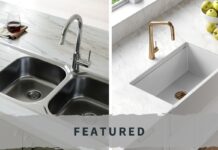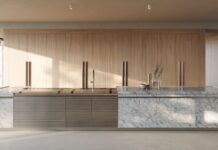Best Practices for Stylish and Safe Spaces
As the population ages and the desire to create inclusive spaces grows, designing kitchens that are both stylish and accessible has become an essential skill for Australian designers. Kitchens should be functional, safe, and accommodating for all users, including those with disabilities or aging-related mobility issues.
Understanding the Needs of Aging Clients and Those with Disabilities
Before diving into design specifics, it’s important to understand the unique needs of aging clients and individuals with disabilities. This includes considerations for mobility, reach, strength, and vision. The goal is to create a space that allows for independence and comfort while ensuring safety and functionality.
TKBB spoke to a number of experts in this area for their tips on designing a liveable and adaptable home. Liz Grimmett, designer and trainer with Designer Training Australia, says “Consider an even wider gap than the standard 1.2 metres between benchtops to allow for manoeuvrability of wheelchairs or walkers, and non-slip surfaces in the kitchen are a must. Lever taps are best for those with reduced hand function and I like to include power points and switches on a rocker which are easier to use”.
Clinton Norris, National Business Development Manager – Assisted Living for Hafele Australia, says that a liveable and adaptable home is one that can change with the needs of the occupants without the need for costly renovations. “We need to be thinking about the changing needs of individuals and enhancing the environment to facilitate independence. Independence is what gives us dignity and the design community has an opportunity to approach the built environment in a way that does not impede this independence,” he adds.
Best Practices in Accessible Kitchen Design
- Layout and Space Planning
Traffic management
The main traffic pathway, connecting the sink, stove, and refrigerator, should be adapted to ensure ample space for movement and connectability between the spaces. Pathways should be at least 1.2 meters wide to accommodate wheelchairs or walkers, ensuring easy navigation and reducing trip hazards.
Manoeuvrable Benchtops
Incorporate benchtops at varying heights to accommodate different tasks and users. Look for motorised options that allow for moveable heights that allow the benchtop to be optimally positioned to suit the user and the function being carried out at the time.

Accessible Cabinets
Consider recommending options such as glass-fronted cabinets or open shelving that make it easier to see inside and reach items without the need for extensive bending or stretching. Pull-down shelves or motorised lowering and raising options can be installed in upper cabinets for added accessibility.

“You could also think about a 760mm section with no cabinets underneath to allow for wheelchair access,” suggests Liz. “But when you take away storage under bench you have to think about where else can you add it back in”.
- Accessible Appliances
Side-Opening Ovens and DishDrawer Dishwashers
These appliances are easier to access than traditional models. Side-opening ovens prevent the need to lean over a hot door, while drawer dishwashers can be installed at a height that minimises bending which also assists with loading and unloading.

Induction Cooktops
Induction cooktops are recommended for older or less able users as they reduce the risk of burns, accidentally leaving the appliance on, or loose clothing being caught in an open flame. They add an extra layer of safety in that they cool down almost immediately.
Refrigerators with Pull-Out Shelves
These models allow for easier access to items without deep bending. French door refrigerators with a freezer drawer are also a good option as they minimise the need to lean down to access food.
Efficient Rangehoods
Ensure you specify a powerful rangehood to ensure cooking odours, as well as splatters from grease and cooking activity, are quickly whisked away.
- Ergonomics
Lever-Style Handles
Lever handles on taps and doors are easier to use than traditional knobs, particularly for those with arthritis or limited hand strength.
Touchless Tapware
These taps are both hygienic and user-friendly, reducing the need for manual operation.
Low maintenance surfaces
Specify low maintenance surfaces that promote hygiene and reduce the need for over-zealous cleaning.

- Lighting and Visibility
Task Lighting
Consider the positioning of installed lighting in and around work areas such as benchtops, stove and sink. Ensure general lighting is enhanced by task lighting that throws light directly onto the work surface, rather than from behind where it will cast a shadow.
“It sounds like a no brainer, but really good task lighting above workspaces in the kitchen can make it so much easier for everyone who uses that space,” says Liz. “Sensor lights are a great inclusion – both inside and outside the home – to help with navigating the space at night”.

Ambient and Natural Light
Maximise natural light through windows and skylights, and use ambient lighting to ensure the kitchen is well-lit. Dimmers can help adjust lighting to different needs and times of the day.
Contrasting Colours
Including strongly contrasting colours can assist those with vision impairments or memory issues to help identify work zones and more safely navigate around the kitchen space.
- Storage Solutions
Pull-Out Shelves and Drawers
Full-extension drawer runners are a minimum requirement for a functional accessible kitchen but also investigate pull-out shelves for pantry areas to allow for full accessibility without bending or excessive reaching.
Rotating fittings
These can be installed in corner cabinets to make better use of space and provide easy access to stored items. Or consider rotating options that do not encroach on the usable space.

Adjustable Shelving
Allows customisation of cabinet interiors to suit the user’s specific needs and preferences, and is usually designed to suit particular items that need to be stored. Consider a motorised option for heavier kitchen appliances such as a stand mixer, so they don’t need to be lifted onto a benchtop for use.
“Our homes are often not designed to accommodate changing needs over time,” says Clinton. “The challenge is always to find the balance between architecture and practicality. And this can come down to something as simple as choosing a door – should it be a swing door, or a sliding door? Should the doors be automated? Will you specify a handle or a knob?”.
- Integrating Style with Accessibility
Modern Design Aesthetics
Everyone deserves a stylish and functional kitchen, even in an accessible kitchen. Use modern, clean lines and high-quality materials to maintain a contemporary look. Integrate accessible features seamlessly to avoid a clinical appearance.
Custom Solutions
Customised cabinetry can be designed to accommodate individual items, such as the width of a wheelchair. Grab rails can be included (and double as handles, if needed) to assist with navigation. Internal organisational systems can make individual items easy to access, locate and pick up.

Stylish Safety Features
Grab bars, handles and other safety equipment can be specified that complement the kitchen’s design. Many manufacturers offer sleek, stylish options that blend with modern décor.
“When designing for accessibility it’s important to change the mindset to focus on how the environment can change over time,” adds Clinton. “The environment is what will hamper the liveability of the space and we all deserve an environment that’s conducive to our wellbeing and living well”.
Liz adds, “The Baby Boomer generation is a huge demographic and we want to encourage people to stay at home for as long as possible. This means our approach to the internal environment has to accommodate how our needs change over time – and that starts at the front door”.
As more Australians show a preference for living well in their own home, no matter their needs, it will become more important for the kitchen and bathroom design community to be aware of small inclusions in design solutions that can enhance lifestyles and play a vital role in allowing clients to stay at home for longer. These best practices will continue to evolve at home, ensuring that accessibility becomes a standard design consideration and that our kitchens are adaptable to the changing needs of users to support independence and enhance the quality of life for everyone.




























